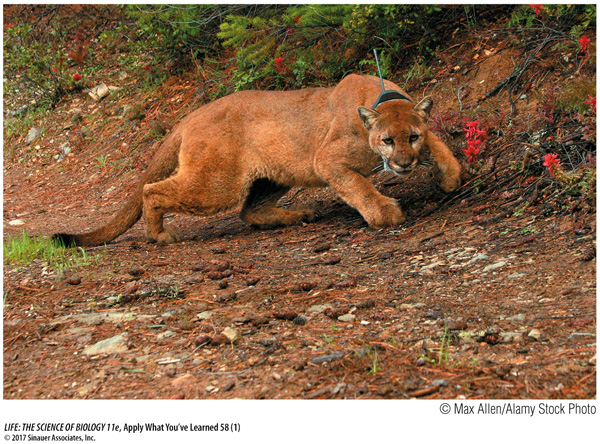Apply What You’ve Learned
Review
58.1
Various factors decrease effective population size, eventually leading to extinction.
58.1
Biodiversity connects species at all levels; its loss affects population, metapopulation, species, ecosystem, and global levels.
58.2
Human-
58.3
Ecologists are establishing protected areas to preserve biodiversity by restricting habitat loss or degradation.
58.3
Coupled human–
Original Paper: Vickers, T. W. et al. 2015. Survival and mortality of pumas (Puma concolor) in a fragmented, urbanizing landscape. PLoS One 10(7): e0131490.
Habitat destruction and exploitation as a result of human activities have led to the extinction of many species. One species that is now endangered is the large cat called the puma or cougar (Puma concolor). Threats to pumas in southern California include habitat loss, habitat fragmentation, and conflicts with humans, which cause population declines, isolation, and ultimately smaller gene pools for the puma.
Two small puma populations occur in southern California between Los Angeles and San Diego. Earlier studies showed that pumas in both populations had very low genetic diversity, and little or no breeding occurred across populations. The populations are separated by urban and suburban areas, including highways, forming a barrier between the Santa Ana Mountains in the west (the more developed area) and the Peninsular Range to the east. Occasionally, however, pumas have been found to travel through agricultural areas, especially in the Peninsular Range.
Scientists fitted pumas in these populations with radio collars to track them and generate data on survivorship and causes of mortality, with the hope of conserving the populations (see figure). Between 2001 and 2013 they captured, marked, and monitored 74 animals in the two populations. Thirty-

| Number of individuals that died (% of population[s]) | |||
|---|---|---|---|
| Cause of mortality | Both populations combined |
Santa Ana Mountains |
Peninsular range |
| Vehicle collision | 10 (28) | 6 (46) | 4 (19) |
| Legal hunting | 6 (17) | 0 (0) | 6 (26) |
| Illegal hunting | 4 (11) | 3 (23) | 1 (4) |
| Suspected disease | 4 (11) | 1 (8) | 3 (13) |
| Confirmed disease | 2 (5) | 0 (0) | 2 (9) |
| Fire | 2 (5) | 1 (8) | 1 (4) |
| Killed for public safety | 1 (3) | 0 (0) | 1 (4) |
| Killed by other pumas | 1 (3) | 0 (0) | 1 (4) |
| Capture- |
1 (3) | 0 (0) | 1 (4) |
| Unknown | 5 (14) | 2 (15) | 3 (13) |
| TOTAL | 36 | 13 | 23 |
Questions
1.
Among the known mortality causes (some are unknown), what are the major causes of death of pumas in these two populations?
Vehicle collisions and hunting, both legal and illegal, are the two known major causes of puma deaths in these populations. Suspected and confirmed diseases together rank as the third most common cause. The two major causes result from human actions, particularly loss of habitat and/or habitat degradation, which forces pumas into urban and suburban areas. Disease is presumably a natural cause.
2.
Using the concept of effective population size, what would the likely effect of reducing puma population sizes be in this region of California?
As effective population size decreases, a population enters an “extinction vortex,” decreasing more every year and becoming more likely to go extinct. The pumas are living in an increasingly urban area and are at risk from vehicle collisions, hunting (both legal and illegal), and other urban-
3.
Discuss how maintaining the puma populations in this region contributes to the overall biodiversity of California.
Maintaining any population and saving it from loss or extinction contributes to biodiversity, because all species and populations are part of biodiversity. Each lost population represents the loss of a strand in the web of life, which is connected to other strands (species) in the community. The puma, as a top predator, contributes to control of its prey populations, which in turn affects lower levels in the food chain, down to producers. Loss of the puma could therefore affect community structure at several levels. This in turn will limit the effectiveness of ecosystem functions and the ecological services (both practical and aesthetic) provided by California ecosystems.
4.
Based on the information provided in the text and table, should conservation methods for maintaining and protecting puma populations concentrate on the Santa Ana population, the Peninsular Range population, or both? Explain your answer.
Both populations are very small, so it makes sense to maximize the size of the gene pool by attempting to conserve both populations. However, finding an appropriate protected area might skew the protection toward one population: the less urbanized Peninsular Range population. If a protected area is identified in the Peninsular Range, habitat corridors could be provided to connect this population with the Santa Ana population, thus extending protection to both populations.
5.
How could the concept of coupled human−natural systems be employed to help maintain the puma populations?
In a coupled human-
Go to LaunchPad for the eBook, LearningCurve, animations, activities, flashcards, and additional resources and assignments.